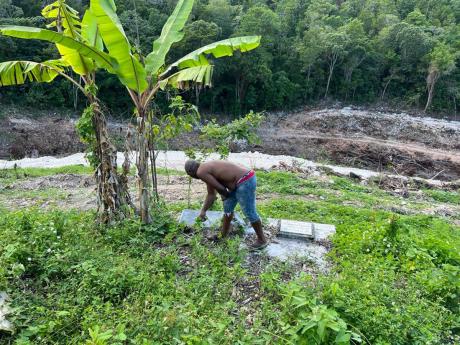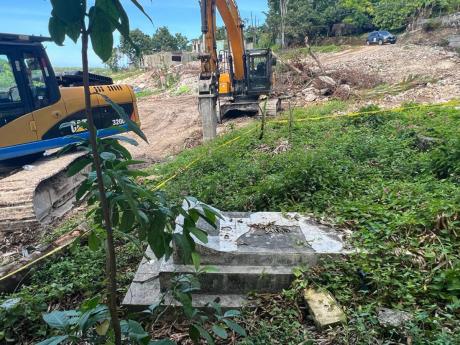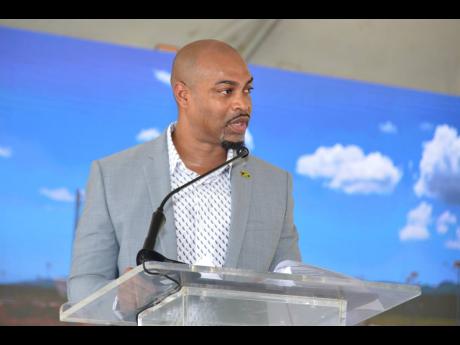Grave worry
Salt Spring residents anxious about reinterment of loved ones to facilitate MoBay bypass
Twenty graves that are in the proposed alignment of the multimillion-dollar Montego Bay Perimeter Road in St James will be relocated to facilitate that leg of the Highway 2000 project.
However, while the affected residents are willing to support the new development, they are concerned as to where the final resting place for their loved ones will be, as the public cemeteries in St James are almost at capacity.
The build-out of the 15-kilometre perimeter road, which starts in Ironshore and bypasses the heart of the Second City before reconnecting along the Bogue road, is being led by the National Road Operating and Constructing Company Limited (NROCC) and necessitates the acquisition of properties, and, in some cases, the relocation of graves or demolition of homes.
The tough inner-city community of Salt Spring, situated just three kilometres on the outskirts of the city of Montego Bay, is one such area affected.
Last month, NROCC, through the finance ministry, put to tender the procurement of grave exhumation, removal and reinterment services for 20 burial sites in Salt Spring, with plans to move them to the “nearest public cemetery/established burial grounds”.
The process has stalled the continuation of that leg of the project, with no clear timeline to complete the reinterment.
GRAVES ON FAMILY PLOTS
The 20 graves identified for relocation are on family plots on the outskirts of Salt Spring. Seventeen are situated in Froggy Lane, while three are in Buck Toe Lane.
Seven of those graves belong to family members of 61-year-old Euriel ‘Charlie’ Francis. These include his great-great-grandparents, parents, two siblings, and a nephew.
“In our first talk with NROCC, the understanding was that we would get the opportunity to choose where the remains would be buried,” Francis, a former craft vendor, shared with The Sunday Gleaner last week.
“But now I am hearing a different story about a public cemetery and what I know is that the only public cemetery close by is Bogue (Pye River Cemetery) and that is full.”
Another resident, who asked not to be identified, is not happy that there is no form of compensation involved.
“We welcome the development because it will increase the value of our community and help to remove the stigma, but they are also moving my mother’s body elsewhere. That is like burying her all over again and to make matters worse, we don’t have much of a say as to where they go,” he said.
The residents recall the horror stories of what occurred during the construction of the Ferris to Mackfield Highway in Westmoreland in 2019, where several graves were unceremoniously dug up during the construction of that leg of the highway.
Several aggrieved individuals had threatened to take legal action against the Government and contractors China Harbour Engineering Company (CHEC) after the remains of several people could not be accounted for.
Residents alleged that along the Whithorn-Haddo stretch of the road, several gravesites were dug up and bones sent flying through the air then crushed beneath the wheels of tractors and traffic before they were covered with marl.
“We were told of one of the skeletons wearing a ‘maroon jacket’ flying through the air. Family members identified that particular skeleton as that of my grand-uncle, Joseph Gallimore, aka ‘Uncle Joe’. Uncle Joe was buried in 1968, so his skeleton was more or less intact. But he, too, had the experience of his bones crushed beneath the wheels of tractors and traffic,” Dr Arufa Cooper recalled then in a submission to The Gleaner.
When they made inquiries, they were told to contact the contracted funeral home, but the home could only account for one of the eight sets of remains. The remains of seven deceased had disappeared.
Cognisant of that, NROCC is now taking great care not to have a repeat of that incident.
“Graves are usually identified before the project starts. However, there are occasions where graves are discovered during the project,” NROCC’s managing director, Stephen Edwards, told The Sunday Gleaner last week, explaining that the project alignment traverses both the Greenfield and Brownfield areas.
Queried on a number of issues, including the cost of the reinterment project, Edwards said the project manager was best able to provide those answers. However, he would not be able to do so until he returns to work from sick leave.
Edwards did note, however, that a bidder has not yet been selected.
A COSTLY EXERCISE
Among those hoping to be selected for the Salt Spring grave exhumation, removal and reinterment project is Dale Delapenha, CEO of Delapenha Funeral Home Limited.
Explaining what the process will entail, Delapenha shared that, “We are guided by the Town and Country Planning Act, which requires that health officials and the police are present and that the exhumation, and reinterment take place before sunrise, so it is a very tight schedule.”
The funeral director admitted that it can be a costly exercise, but refused to discuss the figures.
“The time frame is what makes it so costly, because excavation, opening, removal, and reburial have to be done at once,” Delapenha noted. “It has to be done in a very short time frame and is very labour intensive.”
Several of the affected families are not willing for their departed loved ones to be taken too far from them, and some are demanding that they be reinterned at a private cemetery in the city. However, the funeral director noted that that will mean more cost to the contractor.
ENOUGH BURIAL SPACE IN ST JAMES
Dispelling concerns from the Salt Spring residents, Deputy Mayor of Montego Bay, Councillor Richard Vernon, is confident that there is sufficient space at cemeteries in the parish for a seamless relocation of the 20 graves.
According to him, the St James Municipal Corporation oversees 15 public cemeteries across the parish, including the cholera cemetery on Jimmy Cliff Boulevard.
Vernon said that although the Barrett Town and Pye River cemeteries are almost at capacity, there were 5,261 public burial spaces available elsewhere in the parish.
He also expects additional space to be identified, following an audit that is being done with support from the National Environment and Planning Agency (NEPA) and the St James Health Services.
Vernon noted that, “St James has one of the worst ratios for acreage for burial compared to available land adjoining St Elizabeth and Westmoreland for this region, which is concerning.
“Nevertheless, we are actively assessing lands at our disposal for the purpose of a cemetery; one that must be strategically selected in light of the city’s expansion.”




